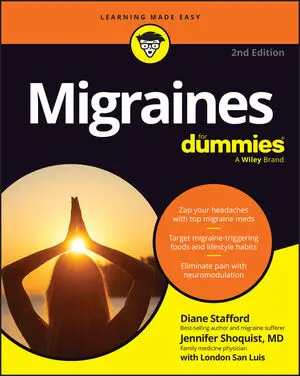This builtin is not currently supported: Animation
- Book & Article Categories

- Collections

- Custom Solutions
 Main Menu
Main MenuBook & Article Categories
 Main Menu
Main MenuBook & Article Categories
Diane Stafford
Diane Stafford has been a health writer for 20 years. She is the coauthor of the popular Potty Training For Dummies.
Articles & Books From Diane Stafford
Listen up and lock down today's best migraine pain solutions Haven't you spent enough time juggling schedules and cancelling events when headache pain sidelined you? You can put those days behind you with up-to-date information on the when-why-how of migraines and a whole-of-body approach to micromanaging them.
Cheat Sheet / Updated 09-15-2025
Today’s jam-packed migraine wheelhouse has treatments and lifestyle tips galore. Luckily, the right options will stop (or limit) your pain and nausea. Simply arm yourself with the latest knowledge on triggers to avoid, the medication that works for you, and a knack for moderating your sleep, exercise, hydration, meals, and stress.
Cheat Sheet / Updated 04-12-2022
Potty training is an important step in childhood development. As a parent, you need to recognize the signs that your child is ready for the toilet talk, institute a potty-training process, keep that process going, and recognize when your child is almost there. Along the way, you need to make sure that your child knows potty-trianing terminology, be able to spot problems that need medical attention, and separate potty-training myths from reality.
Article / Updated 01-23-2017
Keep an open mind as you check out your potty-chair choices: seats that attach to the big toilet, little potty chairs — and don't forget that you can always use that hand-me-down chair (from an older sibling or cousin), and let little sweetkins personalize it with stickers, making the throne hers alone.
Encourage your trainee to sit on different chairs to check out size.
Article / Updated 06-03-2016
Handling the physical aspect of training a child with a disability is wildly different with individual kids, depending on the disability. You may need to provide high-tech props that facilitate movement from walker or wheelchair to the toilet (see the "Working with Special Gear" section in this article.) On the other hand, your child may need nothing more than some bars to grab onto when she's sitting down — and your friendly assistance.
Article / Updated 03-26-2016
As if migraines aren't big enough mischief-makers as it is, they also like to sing show tunes and take on different personas. So here we turn to migraine variants — the exceptions and odd lots that make finding your way to migraine diagnosis and treatment quite a challenging proposition.
Abdominal migraines
Abdominal migraines, which are sometimes diagnosed in children, are unusual because they cause pain in the stomach and lead to nausea and vomiting (sometimes without a headache).
Article / Updated 03-26-2016
Some kiddos' potty programs are thrown off track by outside caregivers who really, truly mean well — but they just don't get why you think consistency from home to daycare is such a big deal.
However, whether caregivers understand or not, most are willing to listen to your comments. Tell them that you believe that changing approaches will mix up your tiny tyke who is barely used to using the toilet, anyway.
Article / Updated 03-26-2016
So you go to see your doctor, and — oops! — you discover that she's just not "into" headache diagnosis. If you're not happy with her response to your concerns, shop around for another doctor. Find a doctor who'll agree to team up with you on a treatment plan. Some primary care doctors are old hands at treating headaches, while others may want to refer you to a headache specialist for diagnosis and treatment.
Article / Updated 03-26-2016
Ask any parent who has taught a child to use the toilet (one who is truthful, anyway), and you'll hear that kids have many pee and poop accidents. Just like when you were learning to drive and didn't get the gist of parallel parking right away, these tots are total novices, and should be treated with gentle understanding when they goof up.
Article / Updated 03-26-2016
Several types of massage can be helpful in relieving the pain of migraine headaches. But there aren't enough studies to show how effective — or ineffective — these therapies are. Typically, migraine sufferers who benefit from massage use it as one component of their pain-relief plan, along with medications, lifestyle changes, and so on.




